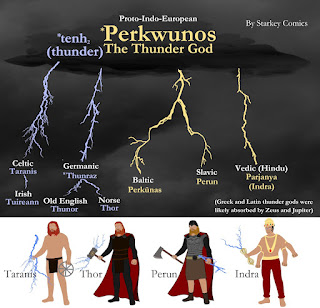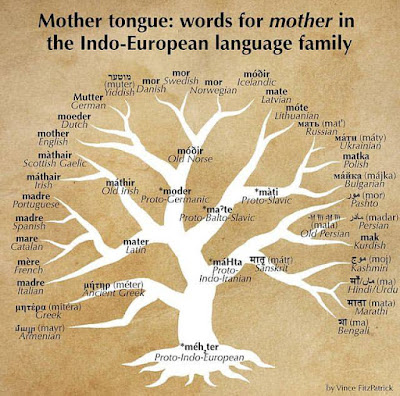Thor and Jörmungandr, and the Story of Ragnarok
And I fell hard, into a dream about the Thunderer in the Proto-Indo-European myths. Perkwunos awoke in my mind, forming a thundercloud that loomed over everything. When I finally pulled myself out of the dream it was past my alarm, and outside the Sky showered the Earth with rain. It is thunderstorm season here.
I admit that Thor has been on my mind, since I associate the midsummer blot with Thor. The coming of the storms brings the water needed for the crops in their big growth time before the harvest. There are also the hot and humid summer evenings when all you can do is sit with a cool drink on a patio and tell stories until they pass.
Moreso, I stumbled across the stories of the Thunderer fighting the great serpent in Proto-Indo-European myths, and became fascinated with how they affected the stories in different cultures stemming from the original Perkwunos story. In all of these stories, the Thunderer fights the great serpent, and in the end in all of them they defeat the serpent. What is interesting is that it is only the Nordic story in which Thor also dies as he defeats the serpent. What does it mean?
Well, there are a number of possible explanations. To me the whole Ragnarok story arch seems as though it was definitely restructured to fit a more Christian narrative. The complete change of character of Loki between that story and other stories is the first hint. It seems likely that early Heathens had a story to explain a cycle of great climate upheaval, but the level of devastation and the way the ship of the dead, Nadglfar, is described as returning made of fingernails and such seems like some Dante’s Inferno level bullshit to me. (Don’t get me wrong, as far as literature goes Dante’s Inferno is fascinating.) Here is a culture that respects and reveres the dead, and suddenly they appear as demons to reap the destruction of their descendents? Something is up.
So it is not a stretch that the story of Thor and Jörmungandr may have also shifted to match this new Christianized narrative. What better way to reduce the power of the Thunderer, the god of the common people? Suddenly the Thunderer is not so powerful. He too can fall to the great serpent that threatens all of the 9 worlds, the enemy of the Æsir. The mighty Jötunn hunter is fallible afterall.
Who is Jörmungandr though really? We know very little about him other than the Æsir cast him into the ocean and out of Asgard and that he is a great wyrm who only grew in size with time. We know he and Thor seem natural enemies, but what is the significance of him being a serpent while his brother is a wolf? Wolves are in many ways an easier symbolism to unravel in Nordic mythology. The image of serpent has become so tainted by Christianity that it is difficult to piece apart the original meaning.
Our best bet is to go further back. If we look at the Perkwunos story, the serpent is a multi-headed hydra and the “blocker of waters” and when Perkwunos smashes in its heads then torrents of rain are released on the parched earth. Jörmungandr was originally the cause of droughts. In general, wyrms and serpents in the ancient world were seen as the bringers of pestilence and disease and putrefaction.
But as time went on the serpent became associated with other things, the cycles of death and rebirth and transformation. Later still Jörmungandr became associated with the serpent Ouroboros biting his tail, a symbol of fertility. This had to do with the shedding of the skin being seen as a sort of rebirth or renewal. This is how Jörmungandr came to represent primal regenerative chaos rather than drought as it was in the original story.
If we look at the relationship between Thor and Jörmungandr, they have a shared history of enmity. Thor meets Jörmungandr three times in the Lore. The first is when Thor tries to lift Jörmungandr, thinking him to be the cat of the Jötunn, Utgarða-Loki. The second is during Thor’s ill-fated fishing trip with Hymir. Finally, Thor and Jörmungandr meet in battle at Ragnarok. But why does it take Thor’s death to defeat Jörmungandr? It feels like a martyr type sacrifice, like the Christ resurrection story, except Thor is dead without a chance of resurrection. It is Midgard that is reborn from this sacrifice.
This is where I feel stuck. We absolutely need a story warning us of the cataclysmic environmental events, but why does the Thunderer die? We need him just as much as Midgard is reborn. (If we are there at all when that happens.)
I believe that Ragnarok is a cycle, a time of climate change that naturally occurs in the Earth leading to flooding or burning periods. That doesn’t mean our actions cannot increase the severity though, and the Earth Mother may yet decide to purge herself of us in one of these cycles so that Midgard can be reborn, cleansed of the troubles we have caused. I don’t know if the elder Heathens ever imagined such an event. To them a regular flooding or burning cycle would have seemed devastating already. And the years in which the Sky was blanketed in volcanic ash blocking out the Sun would have felt like the Fimbul winter described at the onset of the Ragnarok story. The Earth has these cycles and always has. To our ancestors they would have seemed much bigger and scarier without our modern scientific tools for determining weather and cataclysmic events like earthquakes, volcanoes, and tsunamis.
The imaginations of the ancient Heathens turned these cycles into Ragnarok, but still there were more elements changed and rearranged when the stories were recorded by Christians. Ragnarok became an apocalyptic story of devastation, instead of the story of Midgard’s transformation.
And Thor died.
Without Thor, the elder Heathens went looking for a new god to protect the common people. Christianity found its foothold at last. With the original meaning of the story lost, we began to forget about the cycles of the Earth Mother. We forgot the power of the Thunderer. We let a world of efficiency and progress drive us away from our roots as beings of Midgard. Over time we have let ourselves believe we are other to the animals and the plants and to the beings of natural places. We isolated ourselves thinking that we are no longer connected to those cycles, labelling them as primitive. But … the Earth Mother will remind us where we came from, one way or another. If we don’t find a way to be in better harmony with her, then it may be a rude awakening.
Further Reading:
“The Pre-Viking Legend of Ragnarök” https://www.thoughtco.com/ragnaroek-norse-myth-4150300
“Considering the Source: Snorri's Prose Edda” https://blog.amaliadillin.com/2010/09/considering-source-snorris-prose-edda.html
“The role of serpents and dragons in Norse mythology” https://atlanticreligion.com/2014/04/23/the-role-of-serpents-and-dragons-in-norse-mythology/
“Perkwunos: The Original Thunder God" https://starkeycomics.com/2019/03/21/perkwunos-the-original-thunder-god/
“Perkwunos”
https://en.wikipedia.org/wiki/Perkwunos
Encyclopedia of Indo-European Culture by J.P. Mallory & By Douglas Q. Adams
"Mythological Concept of the Thunderstorm in English, Swedish, and Slavonic Song Discourses" by A. V. Gusar
The Gods of the Celts and the Indo-Europeans by Garrett Olmsted
Deep Ancestors: Practicing the Religion of the Proto-Indo-Europeans by Ceisiwr Serith
Image Sources:
“neolithic cave painting of Thunder god Perkwunos, defeating a giant serpent with his hammer” Image created by the AI at https://www.craiyon.com/
“Perkwunos” an etymology table by Starkey Comics (link above, under Further Reading)
.jpg)



